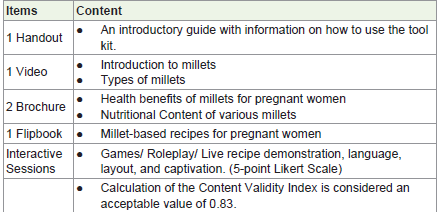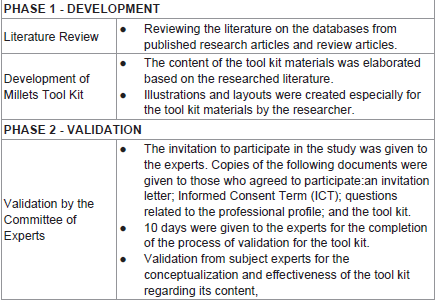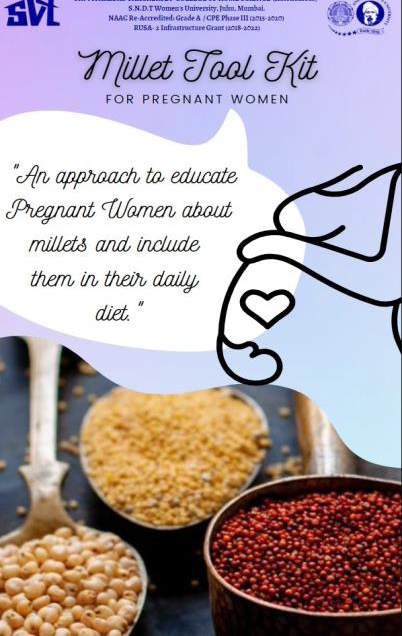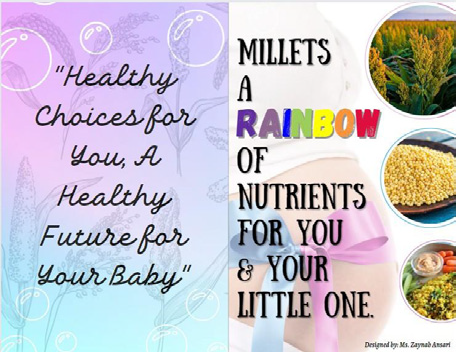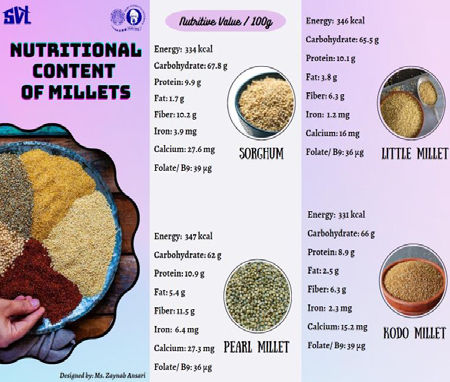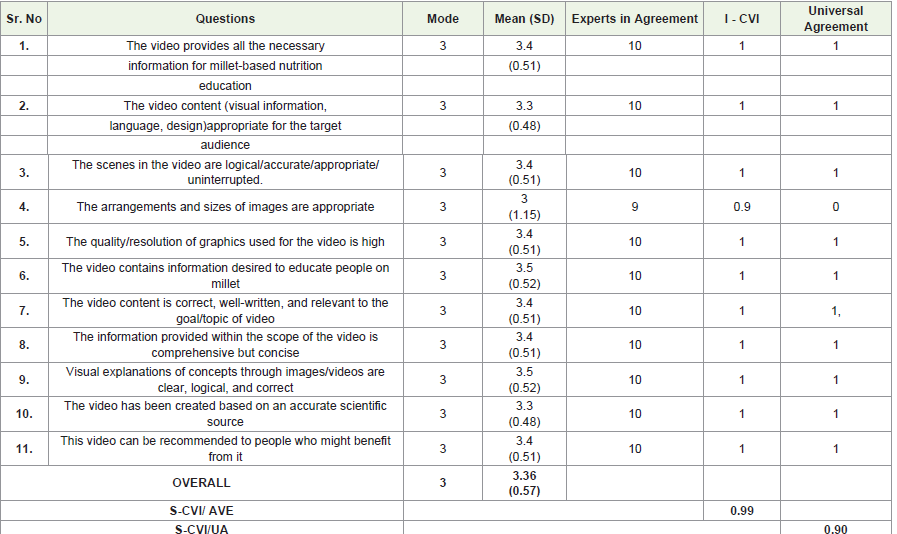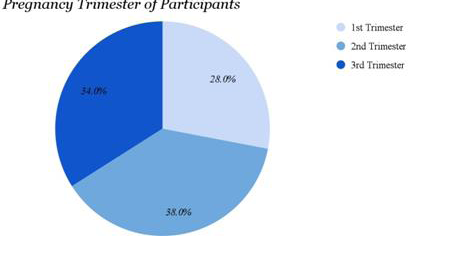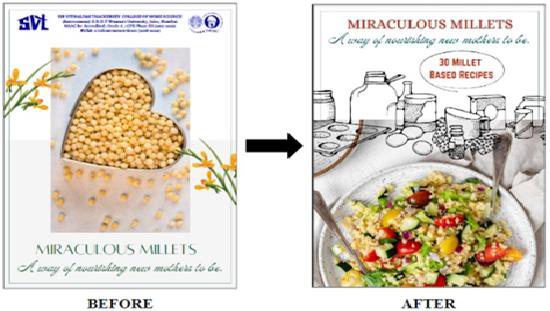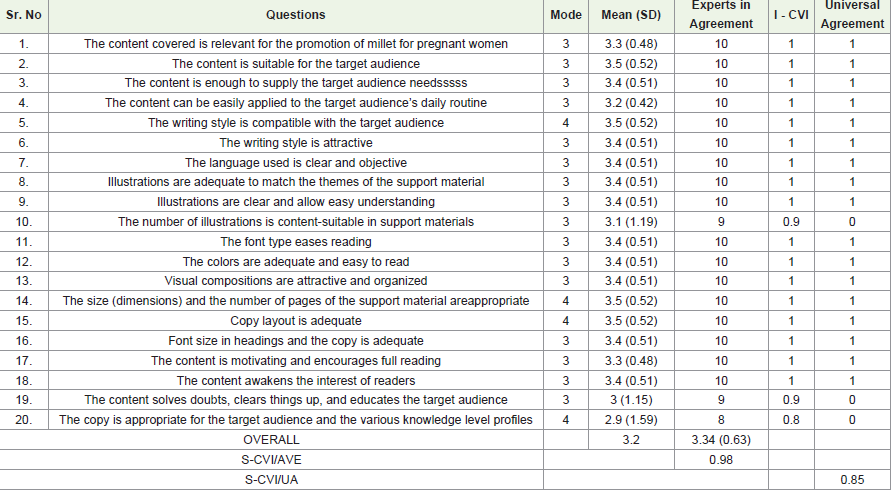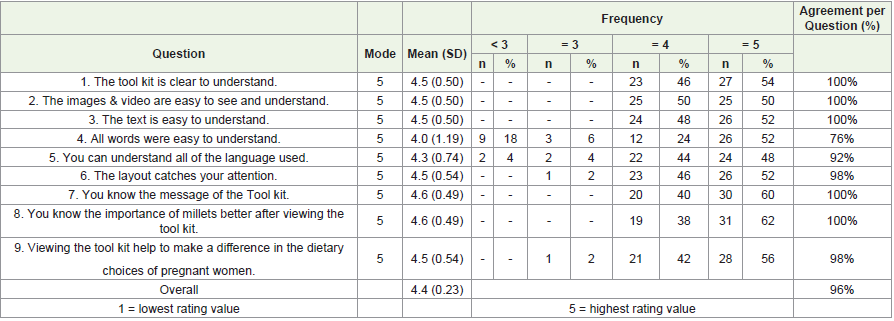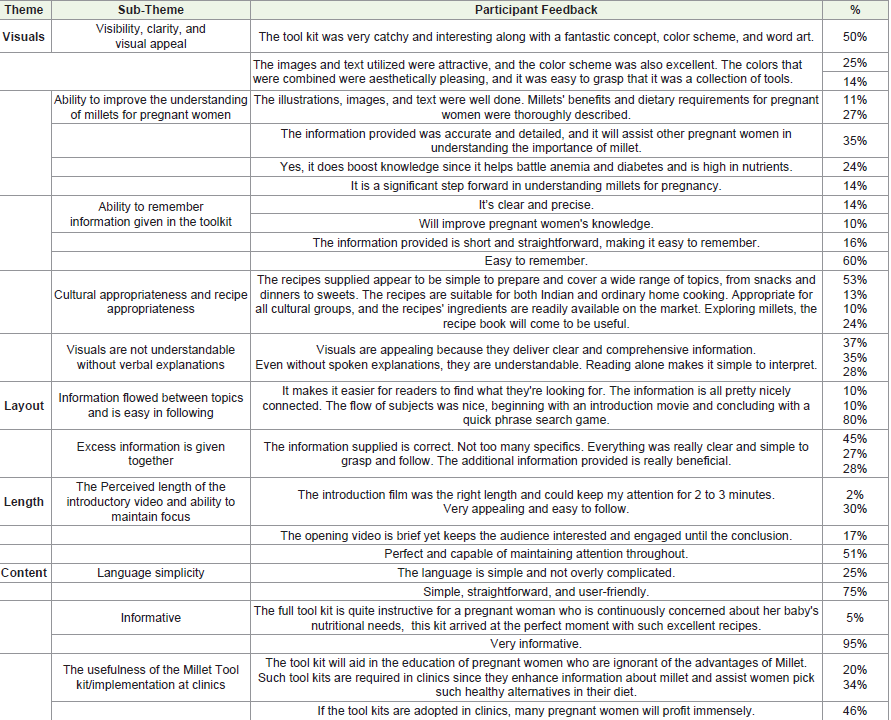Research Article
Development and Validation of Nutrition Education Tool Kit on Millets for Pregnant Women: A Cross-Sectional Study
Ansari Z*, Madan J and Patharia Z
Department of Food Nutrition and Dietetics, Sir Vithaldas Thackersey College of Home Science (Autonomous) SNDT Women’s University, Juhu Tara Road, Mumbai India
*Corresponding author: Zaynab Ansari, Department of Food Nutrition and Dietetics, Sir Vithaldas Thackersey College of Home Science (Autonomous) SNDT Women’s University, Juhu TaraRoad, Mumbai India, E-mail Id: zaynabansari00@gmail.com
Article Information: Submission: 13/09/2023; Accepted: 30/09/2023; Published: 03/10/2023
Copyright: © 2023 Ansari Z, et al. This is an open-access article distributed under the Creative Commons Attribution License, which permits unrestricted use, distribution, and reproduction in any medium, provided the original work is properly cited.
Abstract
Background: Millet consumption has vanished due to excessive processed food consumption, and it is prudent to enhance millet consumption since millets are abundant in various nutrients. Nutritional inadequacies can cause pregnancy issues such as anemia, pregnancy-induced hypertension, and gestational diabetes. It might be stated that pregnant women’s understanding of nutrition education is essential for creating nutrition interventions. This study developed and validated a nutrition education tool kit on millet for pregnant women.
Methods: The research was divided into two phases. The expert panel (n = 10) included clinical dietitians, academics, and obstetricians with expertise in the field of women’s health and nutritional education. The participants (n = 50) were pregnant women. The validation framework of the tool kit was designed with each component of content and face validity in mind. A five-point Likert scale questionnaire, feedback, and recommendations were employed to examine content validity. An index greater than 0.83 was considered acceptable for content validity. Results: The millet tool kit for pregnant women included: (1) A handout; (2) A film; (3) A two-fold brochure; (4) A tri-fold brochure; (5) A flipbook containing information on millet, its health advantages, millet-based recipes, and how to include them into the daily diet. With a CVI of 0.98 for the Millet Tool Kit, the experts felt that the Millet Tool Kit was adequate in terms of visual appeal, organization, pace, language, and understanding. Participants also thought the Millet tool kit was distinctive with a 96% approval percentage.
Conclusion: The tool kit was valid and can be considered educational material for pregnant women in the community to modify their nutrition and encourage them to eat a healthy diet that includes millet, as well as possibly improving its effectiveness when used by healthcare providers in public healthcare settings.
Methods: The research was divided into two phases. The expert panel (n = 10) included clinical dietitians, academics, and obstetricians with expertise in the field of women’s health and nutritional education. The participants (n = 50) were pregnant women. The validation framework of the tool kit was designed with each component of content and face validity in mind. A five-point Likert scale questionnaire, feedback, and recommendations were employed to examine content validity. An index greater than 0.83 was considered acceptable for content validity. Results: The millet tool kit for pregnant women included: (1) A handout; (2) A film; (3) A two-fold brochure; (4) A tri-fold brochure; (5) A flipbook containing information on millet, its health advantages, millet-based recipes, and how to include them into the daily diet. With a CVI of 0.98 for the Millet Tool Kit, the experts felt that the Millet Tool Kit was adequate in terms of visual appeal, organization, pace, language, and understanding. Participants also thought the Millet tool kit was distinctive with a 96% approval percentage.
Conclusion: The tool kit was valid and can be considered educational material for pregnant women in the community to modify their nutrition and encourage them to eat a healthy diet that includes millet, as well as possibly improving its effectiveness when used by healthcare providers in public healthcare settings.
Keywords: Millets; Nutrition Education; Pregnant Women; Tool Kit
Abbreviations:
CVI - Content Validity Index; I-CVI - Item-level Content Validity
Index; S-CVI/AVE - Scale-level Content Validity Index based on the
Average Method; S-CVI/UA - Scale-level Content Validity Index
based on the Universal Agreement MethodIntroduction
The Lancet Commissions’ recent paper [1] recognizes the need
for identifying healthy and environmentally sustainable diets, as well
as increased utilization of underutilized plant species, such as quinoa,
millets, and sorghum, due to their climate resilience and dense
nutritional content. It was demonstrated that, out of 14,000 edible
plants, only major crops, rice, maize, and wheat, account for 60% of
calorie consumption. On the other hand, the Sustainable Development
Goals (SDGs) 2030 have an ambitious goal of eliminating all forms of
malnutrition by 2030. To do this, initiatives are needed to replace the
majority of rice, wheat, and maize in the diet with highly nutritious
grains such as millet.
Millets are “yesterday’s coarse grains and today’s Nutri-cereals.”
Because they are resilient to most pests and illnesses and can thrive
in the difficult conditions of the arid and semi-arid regions of Asia
and Africa, millets are regarded as “future crops.” Millets are small-seeded
grains, with sorghum, pearl millet, finger millet, proso millet,
Kodo millet, foxtail millet, and little millet being the most common
and important for food [2].
Nutri-cereals are making a strong comeback in the Indian cereal
production segment after decades of neglect. Although India ranks
first in the world in nutrient-rich millet production and second in
rice and pulses, it also ranks second in child malnutrition incidences.
India is home to more than one-third of the world’s malnourished
children [3]. Millets are three to five times more nutritious than
some other cereals (rice, wheat, maize) in regards to vitamins, fiber,
proteins, and minerals (iron and calcium), and they are gluten-free;
thus, they are referred to as “super foods” [4].
Millets are an exceptionally beneficial crop that contains a
significant amount of minerals and vitamins. Millets are packed
with calories, dietary fiber, slowly digesting starch, and resistant
starch, and hence provide prolonged glucose release and satiety [5,6]. Millets are packed with protein and sulfur-containing amino acids (methionine and cysteine) than cereals and have a higher fatty acid profile [7]. On the other hand, they have a limited quantity of
lysine and tryptophan, which varies according to the cultivar. They
also include vitamins E and B and minerals including calcium,
phosphorus, magnesium, manganese, potassium, and iron [8]. As a
result, millets play a significant role in the modern diet as a possible
supply of key nutrients, particularly in emerging and underdeveloped
countries.
Diet and behavior are highly changeable elements that can aid
in preventing or treating new instances of lifestyle-related chronic
diseases. These parameters can be changed by population-specific
nutrition education. Malnutrition among schoolchildren, pregnant
women, breast feeding moms and other vulnerable members of the
community are mostly caused by a lack of awareness about food’s
dietary requirements and nourishing prices [9]. Pregnancy is a
fragile and crucial time in a woman’s life because it causes physical,
physiological, hormonal, and Anatomical changes. Pregnant women must make lifestyle
changes to accommodate these changes [10,11]. A healthy diet,
according to the World Health Organization [WHO], includes
enough calories, protein, vitamins, and minerals from various foods
[12].Nutritional deficiencies can lead to pregnancy issues such as
anemia, miscarriage, pregnancy-induced hypertension, gestational
diabetes, and early or cesarean birth [13,14].
Pregnant women’s dietary knowledge is critical to achieving
a favorable pregnancy outcome, whether for the mom or the fetus
[15]. Evidence suggests that pregnant women in many countries
have poor nutrition knowledge and behaviors. This was the situation
for 616 Ethiopian pregnant women, 38.6% of whom showed low
nutritional ability and 60.7% indicated poor dietary behaviors [16].
In agreement, Syrian refugee women in Lebanon were found to have
limited nutritional knowledge and poor dietary behaviors during
pregnancy (56% and 47%, respectively) [17]. According to the WHO
(2016), healthcare providers should deliver nutrition instructions
at each ante partum visit. Previous research has demonstrated that
health education has a favorable influence on pregnant women’s
dietary knowledge and habits. For example, when 406 pregnant
women in Ethiopia were studied for the influence of nutrition
education on dietary knowledge and behavior, it was shown that
knowledge of good nutrition rose from 53.9% to 97%, and dietary
practice improved from 46.8% to 83.7% [14].
In conclusion, it can be addressed that pregnant women’s
understanding of health information requirements, resources of
healthcare information, and obstacles to obtaining health information
are crucial for creating health interventions and the provision of
high-quality prenatal care.
Furthermore, while healthcare providers play an important
role in educating patients in the clinic, community, or healthcare
center, nutrition education should be practical and easily adaptable
to the socioeconomic status, food habits, and the available local food
resources generally needed for demonstration and feeding the locally
available audience. Nutrition education programs should become a
part of the community.
Currently, there is no nutrition education tool kit on millets
for pregnant women, to provide knowledge about millets and
incorporate them into their daily diets. By creating awareness about
millets and educating pregnant women on the importance of millets
in their daily diet, their health benefits will be much better realized.
Hence, this study aims to develop and validate a nutrition education
tool kit on millets for pregnant women that are easy to understand
and handle and tested and validated by professionals, to ensure that
all information is properly assimilated.
Material and Methods
The aim of the study was to develop and validate a nutrition
education tool kit on millets for pregnant women. This chapter
discusses the study’s materials and methods. The research was
conducted in two phases over six months. The study used a mixedmethod,
concurrent, Cross-sectional study design in which data were
collected using a 5-point Likert Scale.
The study was conducted using a stepwise approach to achieve
two objectives:
(1) The development of a nutrition education tool kit on millets
for pregnant women and
(2) The validation of the tool kit on millets using two parameters
namely content validity and face validity using a framework.
The target population was Pregnant women between the age group
19 - 45 years. The sample size included the expert Panel consisting
of 10 experts, including 4 clinical Dietitians, 4 academicians, and
2 Obstetricians. The sample size of the target population was 50
participants aged 19-45 years residing in Mumbai, India. The Experts
and participants were recruited through a purposive sampling
method. The experts were recruited based on the following inclusion
criteria: Clinical Experience in the field of Nutrition, Dietetics, and
or/Obstetrician; Graduate Qualification - Specialization, Master or
Doctorate; and Average Professional experience of 10-15 years. The
experts were eliminated based on the following exclusion criteria:
Experts who are unable to complete the validation process within the
specified period. The following inclusion criteria were used to choose
participants: Pregnant Women 19 - 45 years old; and Pregnant
Women in their First, Second, and Third Trimester. Participants
were eliminated based on the following exclusion criteria: Pregnant
Women residing out of Mumbai. The study was conducted for 4
months.
The ethics committee approval was obtained from the Inter
System Biomedica Ethics Committee (ISBEC) before the start of the
study. All necessary precautions were considered to prevent a breach
of confidentiality and disregard of consent. The experts explained
in detail about the study by providing an expert information sheet.
Written informed consent and professional profiles of experts
were obtained. The participants were also explained in detail about
the study by a participant information sheet and written informed
consent was obtained.
The research study was conducted in two phases: development
of an educational tool kit for pregnant women to educate about
millets and incorporate them into their daily diet; validation of the
educational material by experts; and legitimization of the educational
material by pregnant women. After reviewing the literature on the
databases of Medline (PubMed) National Institute of Health (NIH),
and web pages such as the Indian Institute of Millets Research
(IIMR), and World Health Organization (WHO), journals such
as Nutrients, International Journal of Public Health and Clinical
Sciences an educational tool kit consisting of educational materials
were developed, with emphasis on official information on millets and
their health benefits for pregnant women appropriate to the Indian
context.
The educational tool kit was created by the guidelines for the
conception and efficacy of educational items, which included content,
language, organization, layout, illustration, learning, and motivation
considerations. Production of educational materials sought to
encourage pregnant women to consume millet and gain knowledge
on their health benefits.
The researcher worked on graphic design and illustration using
Canva and Inshot for the items in the tool kit. Images were gathered
from the website. The tool kit was made in 3 different languages:
English, Hindi, and Marathi for better understanding. The tool kit
included the following items in [Table 1] in detail.
For the validation process, 10 experts participated. It is
noteworthy that in the selection of experts, the researcher considered
clinical dietitians, academicians, and obstetricians with experience in
the following areas of care, teaching, and research: women’s health
(pregnancy – prenatal), public health, and health education. Data
were collected from February to March 2023.
The validation framework for the tool kit was developed
considering all the aspects of content validity and face validity.
Content validity was assessed using a five-point Likert scale: strongly
agree, agree, neutral, disagree, and strongly disagree. In addition, the
questionnaire included open questions for comments and feedback.
The scale elements included questions on the relevancy of the
material, the simplicity and comprehensiveness of the information,
the appropriateness of illustrations, the length of the sessions for the
quantity of text to be taught, and so on. All of the questions were
asked in a positive tone.
Regarding the evaluation of the millet tool kit its content and
layout through face validity; pregnant women were invited to
participate in the study with a participant information sheet. A
total of 50 pregnant women agreed to participate in the study. The
validation process was conducted after the changes made in the tool
kit as per the expert’s recommendations. The final version of the tool
kit was defined based on the suggestions made by the experts, trying
to adapt it to the target audience as much as possible. For evaluation
by the pregnant women, a final version of the tool kit was delivered
along with the guidelines for signing the Terms of Free and Informed
Consent. Pregnant women were asked to grasp and evaluate the
tool kit’s figures and text with the help of an evaluation form which
included open and closed-ended questions and was evaluated by a
5-point Likert Scale.
A study assistant was instructed to undertake the reading for
pregnant women who could not grasp the printed content. An
instrument was created to assess the social profile of pregnant women
(age, level of education, occupation, and family income). A brief
questionnaire was created to determine face validity. The women
were asked about their thoughts on the cover, title, subtitle, content,
writing, graphics, learning motivation, graphics, learning motivation,
and cultural components. During the interviews, notes were taken
regarding remarks, thoughts, and ideas about the millet tool kit.
The entire phase of development and validation is summarized in
[Table 2] .
Data were collected, coded, and then given for statistical analysis.
Analysis was done using Statistical Package for Social Sciences
(SPSS) software. Statistical analysis of the agreement, according
to each item of the tool kit, was performed using the adequacy of
proportions adjustments of experts who agreed with the relevance of
the educational tool kit.
Results
Development of The Millet Tool Kit:
The review and data supplied the key priority areas to addressthe participants with educational sessions while keeping the research
objectives in mind. The review and resource materials from national
and international sources were reviewed. Following a series of
discussions with subject experts and data from the literature, it was
determined that the millet tool kit for pregnant women includes all
information on millet, its health advantages, and how to include it in
the daily diet.
Following was the final version of the tools incorporated in the
Millet Tool Kit after validation by the experts
Handout:
Following the completion of the text, the researcher used Canva
to create visuals and layouts. The size of the handout was 11.4 x
6.4 inches (length x breadth). The handout was a single double-sided
leaflet with a cover [Figure 1] and a back cover. It explained
how health educators, dietitians, obstetricians, other health care
and nutrition experts, social workers, youth advisers, and program
directors might utilize the millet tool kit to help pregnant women
eat and live healthily. It was intended to act as a nutrition education
resource while also providing a brief overview of the items included
in the tool kit.Video:
The introduction millet video was created in two steps using nonempirical
approaches. The literature was researched in the initial step
to determine the parameters for planning and producing the video. In
step 2, the video was created. When producing a video for the target
population, the literature review emphasized the need for the proper
cognitive load. The cognitive load was lowered by utilizing basic
language and layout, common terms, clear short phrases, images from
the internet and some filmed by the researcher, a low-pitch human
voice, a medium to slow speed, and keeping the presentation brief.
The film lasted 5 minutes, and these parameters were followed while
assuring the relevancy and correctness of material to create a video
using Canva and In shot, an app used for video editing. The video’s
content was focused on the introduction of millet, millet-producing
states in India, millet species present in India, millet types, and its
health benefits, as well as India’s role in proclaiming the International
Year of Millets 2023.Two-fold Brochure:
The size of this brochure was 8.25 x 5.25 (length x breadth)
inches. Following the expert content validity, the final version had
6 double-sided pages with a cover, a back cover, [Figure 2] a brief
introduction to millets and kinds of millets, and a summary of its
general health advantages. It also included information on nutrition
during pregnancy, nutrient requirements throughout pregnancy, and
the health advantages of millets during pregnancy, as well as strategies
to include millets into the diet and how millets are experiencing a
gourmet revival. The two-fold brochure included seven subjects in
total, including an introductory page for each session topic, important
messages, graphics, photos, and one-liner takeaway messages.
The brochure was pink and blue and titled “Millets a Rainbow of
Nutrients for You and Your Little One” to symbolize the baby’s
gender. The pamphlet was meant to be utilized by pregnant women
during sessions to validate the tool kit from them.Tri-fold Brochure:
The trifold brochure, titled “Nutritional Content of Millets,”
[Figure 3] was 7.5 x 3.5 inches in size (length x breadth). It listed
the nutritional composition as well as the price per 100 g of each
millet.Flipbook:
The flipbook was a recipe book featuring 30 millet-based meals.
It measured 11.7 by 8.5 inches in dimension (length x breadth). The
recipe book was named “Miraculous Millets - A Way of nourishing
new mothers to Be” and included a front and back cover. It had
21 double-sided pages in total. The colored book was white with
an appealing cover page. Five recipes from each category such as
Millet-based salad, soup, dosa and paratha, one pot meal, munchies/
snacks, dessert, and beverages were all included in the recipe book.
Following the cover page, a list of abbreviations was included as well.
The flipbook included information on the recipe ingredients, how to
make the meal, the number of servings, and the nutritional content of
each recipe. The flipbook was designed to be utilized by participants
and peers after the tool kit had been validated.Professional Profile of the Experts:
Among the sample of 10 experts, composed of academicians,
clinical dietitians, and obstetricians all agreed to participate in the
evaluation, and all evaluation tools were returned with analyses duly
completed and open questions accordingly filled in. The expert’s
validation was done through face validity and content validity.Regarding the professional profile, it was observed two experts
with doctoral degrees among which one had a Doctorate of medicine
in gynecology and another Diploma in Gynecology and Obstetrics,
three with PhDs in Nutrition, Dietetics, and Public Health; four with
master’s degrees in the field of nutrition, dietetics, and food science,
one was a registered dietician after completing her master’s degree.
In their current occupation, three were professors and researchers;
two performed activities in prenatal consultations in hospitals,
one performed teaching activities, and 4 were practicing clinical
dietitians. The mean time of experience of all the experts was 22.0
years (Standard Deviation = 8.2). They were also asked if they had
ever been a part of a research dissertation as an expert, and just four
of the ten experts had been a part of an academic dissertation as an
expert.
Participants Characteristics:
Of the 50 eligible participants, all pregnant women agreed to
participate (100%) in the study. The mean age of participants was 28.2
years. Women with both low and high socioeconomic backgrounds
were included in the study. The participant’s pregnancy trimester is
seen in [Figure4].Content Validity:
The degree to which the characteristics of an evaluation tool are
relevant to and indicative of the concept being assessed for a specific
assessment purpose is known as content validity. It is essential to
highlight that demonstrating content validity is critical to confirming
the validity of a tool for evaluation such as questionnaires, particularly
for research purposes. Validation of each of the following tools was
done separately. The questionnaire was evaluated through a 5-point
Likert Scale where 1= Strongly Disagree; 2= Disagree; 0= neither
Agree nor Disagree; 3=Agree; 4=Strongly Agree. The mean (S.D) and
mode were calculated along with Content Validity.According to the Universal Agreement (UA), (Yusoff et al., 2019),
method experts scored each item by responding either ‘Strongly agree
or Agree’ which was the proportion of items on the scale that achieved
a relevance scale of 3 or 4 by all experts was given as 1 when the item
achieved 100% experts in agreement, otherwise the score is given as
0 if they responded ‘Neither agree nor disagree, Disagree or Strongly
disagree’ to a series of closed-ended questions. For each item at the
end of the questionnaire, there was a column of recommendations
and feedback which was filled by the experts.
Video:
There was a total of 11 questions which included questions such
as whether the video provides all the necessary information for
millet-based nutrition education; whether the visual information,
language, and design are appropriate or not for the target audience;
the size of images; the quality and resolution of graphics; the video
has been created based on an accurate scientific source and whether
it can be recommended to people who might benefit from it. Experts
scored nearly (n = 109; 99%) of the questions as ‘Strongly agree
or Agree’ responses and only (n = 1; 0.9%) as ‘Neither agree nor
disagree, Disagree or strongly disagree’. The overall mean (SD) of all
the questions was 3.36 (0.57) and the mode was 3. A value of 0.99
was obtained in the S-CVI/Ave (scale-level content validity index
based on the average method) and the S-CVI/UA (scale-level content
validity index based on the universal agreement method) was 0.90
[Table 3] .Brochure:
The questions were arranged into themes, namely
i. content (Q1 – 4),
ii. language (Q5-7),
iii. illustrations (Q8 – 10)
iv. layout (Q11 - 16)
v. motivation (Q17 – 19)
vi. culture (Q20).Experts scored nearly (n = 196; 98%) of the questions as ‘Strongly
agree or Agree’ responses and only (n = 4; 2%) as ‘Neither agree nor
disagree, Disagree or Strongly disagree’. The overall mean (SD) of all
the questions was 3.34 (0.63) and the mode was 3.2. A value of 0.98
was obtained in the S-CVI/Ave (scale-level content validity index
based on the average method) and the S-CVI/UA (scale-level content
validity index based on the universal agreement method) was 0.85
[Table 4] .
Flipbook:
The set of questions (n = 9) for the flipbook included questions
specifically in the recipe book. Some of the questions were whether the
cover page of the r ecipe book is appealing; ingredient list is specified
and whether exact measurements (amount) are mentioned precisely;
the ingredients in the recipe book are easily accessible in the market
to the target audience; the recipes included in the book are easy to
prepare for an enthusiastic home cook and whether the recipes in
the book is suitable for the target audience. Expects scored nearly (n
Figure 4: Participants’ Pregnancy Trimester.
Pregnant women in their second trimester had the greatest frequency (n =
19; 38%). The first trimester had the fewest women (n = 14; 28%), whereas
the third trimester had a greater number of women (n = 17; 34%). None of
the participants ever received any kind of nutrition education on millet and
its health benefits for pregnant women. The participants were informed that
the millet tool kit is available in English, Hindi, and Marathi language. They
were given three alternative languages to pick from, and the majority of the
participants (n = 29) chose English, while the rest chose Hindi (n = 11) and
Marathi (n = 10).
= 89; 98.8%) of the questions as ‘Strongly agree or Agree’ responses
and only (n = 1; 1.1%) as ‘Neither agree nor disagree, Disagree or
Strongly disagree’. The overall mean (SD) of all the questions was 3.36
(0.19) and the mode was 3. A value of 0.98 was obtained in the S-CVI/
Ave (scale-level content validity index based on the average method)
and the S-CVI/UA (scale-level content validity index based on the
universal agreement method) was 0.88 [Table 5] ).
Figure 5: The Recipe Book’s before and after Cover Page.
Pregnant women in their second trimester had the greatest frequency (n =
19; 38%). The first trimester had the fewest women (n = 14; 28%), whereas
the third trimester had a greater number of women (n = 17; 34%). None of
the participants ever received any kind of nutrition education on millet and
its health benefits for pregnant women. The participants were informed that
the millet tool kit is available in English, Hindi, and Marathi language. They
were given three alternative languages to pick from, and the majority of the
participants (n = 29) chose English, while the rest chose Hindi (n = 11) and
Marathi (n = 10).
Expert Recommendations for the Millet Tool Kit:
The comments from the experts were analyzed to identify
common themes (content-based, illustration-based, and layoutbased),
and similar responses were grouped. The experts felt that the
content was appropriate for the millet tool kit and needed for the
populations, except for a few editions. They suggested highlighting
the key points or messages within the sentences based on relevance.Often in the introductory video on millets, a few technical words
were requested to be replaced with easier synonyms in the tool kit.
Furthermore, there were suggestions to insert subtitles or important
points to pop up on the screen in the video as there were certain
segments in the video with only background and narration and no
subtitles; such was suggested as it is an effective way to keep the target
audience diligent and understand. Experts also suggested adding a
short introduction about millets and their general health benefits,
ways to include millets in the diet, and how they can be replaced by
wheat and rice to the brochure titled “Millets a Rainbow of Nutrients
for You and Your Little One”. In the illustration sections, two or
three of the experts recommended making the cover page of the
flipbook which was the recipe book more attractive [Figure 5]. All
necessary improvements were implemented according to the experts’
recommendations. The experts also suggested that the content in the
millet tool kit supplemented the existing knowledge of millets.
Face Validity:
The questionnaire is evaluated for clarity, reasonability, and
applicability using subjective face validity. The clarity of an evaluation
questionnaire indicates that the tool is not difficult to grasp and read
but has suitable instructions to follow. The validation procedure was
carried out using online Google forms as well as printed copies of
the forms filled out by the participants. Experts mainly discussedthe shortcomings of the Millet Tool Kit and gave recommendations
that were taken into consideration and the final version of the tool
kit was given to the participants for validation. Feedback from the
participants was evaluated both individually and collectively to study
linked topics. Keywords were discovered and their context-specific
meanings were defined. The frequency, extensiveness, intensity,
and specificity of answers to the researched topic were employed to
interpret the results from the participant’s perspective. The evaluation
of the participants (n = 50) is summarised in [Table 6] ).
Overall the participant’s agreement percentage for the tool kit
was 96%.
Feedback from Participants on the Millet Tool Kit:
For the participant’s feedback, the questionnaire also included
four main themes, namely visuals, layout, length, and content. The
themes and sub-themes are presented in [Table 7]. The results were
supported by participants’ feedback and are summarized in [Table
7] along with the percentage of women who gave similar responses.Visuals:
Five sub-themes were identified in the visual theme. The
first subtheme was related to visibility, clarity, and visual appeal.
Participants found the visuals to be simple, clear, appealing,
impressive, and eye-catching. The second sub-theme revealed whether
participants gained a better understanding of the tool kit. Participants
mentioned that the visuals helped them to understand millet and its
health benefits. Participants were able to recall some of the content
they learned from the tool kit. The third sub-theme is concerned with
knowledge retention. Participants felt that the visuals helped them
to recall information, especially when combined with audio material.
The fourth sub-theme concerned cultural appropriateness and recipe
appropriateness. Participants felt that the recipes were culturally
acceptable and accessible. The fifth sub-theme was related to whether
the visuals were not understandable without verbal explanations.
Participants felt that it was easy to understand even without verbal
explanation.Layout:
Two sub-themes were included in the layout theme. The first
subtheme dealt with information flow from one topic to the next.
Participants indicated that they felt the flow of information was
smooth and easy to follow. The second sub-theme was whether too
much information was given altogether to which the participants
responded that it was not excessive and on point and that the
information given was useful and adequate.Length:
The participants were satisfied with the length of the introductory
video when viewed. Participants noted that they could maintain their
focus for 2 - 3 minutes while some of them could maintain their focus
throughout.Content:
The content theme was divided into three sub-themes. In terms
of the language, the participants said it was straightforward to
comprehend. Regarding the language simplicity, both participating
groups said that the tool kit content was basic enough for viewers
who saw the tool kit in English, but other groups who will not be able
to grasp English will benefit from viewing in Hindi and Marathi. The
second sub-theme was.Whether the content of the tool kit was informative and whether
the response was positive. Regarding the Millet Tool Kit’s value
for pregnant women in clinics, participants urged that every client
explore the tool kit.
Discussion
The strategy chosen for this Millet Tool Kit for Pregnant Women
arose from a worry about the present situation in which millets are
being ignored and people are ignorant of their health advantages. The
current scenario in the country is that rice and wheat are given more
priority, but millets, while being an important grain in India for a
long time, have currently lost their value.
However, with 2023 being the International Year of Millets and
millets seeing a resurgence it is critical to provide nutrition education
on millets to different individuals in the community.
Pregnant women are one such group since their health is crucial
to the sustenance and growth of both their baby and themselves.
Fetal issues such as neural tube defects, intrauterine development
retardation, and low birth weight can be caused by nutritional
deficits during pregnancy. Anemia, miscarriage, pregnancy-induced
hypertension, gestational diabetes, and early or cesarean birth can all
be caused by nutritional inadequacies [13,14].
The current study sought to develop and validate a Millet Tool Kit
for Pregnant Women to assess its efficacy in transferring knowledge
into action. A particular strength of the Millet Tool Kit was its
simplicity. It was developed to convey complex concepts simply. The
tool kit also depended on the use of colors and images, which may
have aided in knowledge retention and impact.
Simple phrases and linguistic patterns were used to create the
tools in the tool kit (i.e. brochure, video, and flipbook). Further
emphasizing the cultural relevance of the graphics by integrating
traditional cuisine was also attempted.
It is critical to incorporate culturally and socioeconomically
relevant visuals for the audience to relate to the educational material.
Allowing the audience to relate to the content can improve its efficacy
and bring attention to key facts [18]. A significant effort was also
made to improve the coherence of the tool kit’s material. To promote
knowledge retention, the material was structured rationally. Using
a suitable layout increases the visibility of crucial text, images, and
concepts while decreasing the amount of time spent looking for
information [19,20].
Because properly created educational content has the potential
to influence a population’s reality, we must assess which information
is intended and what is anticipated. In this sense, the study evaluated
the effectiveness of the nutrition education millet tool kit which was
used to empower pregnant women to improve their diet through
millet a nutri-cereal. Another research found that nutritional
counseling was extremely important, with 94.6% of nurses agreeing
that recommendations on maternal nutrition during pregnancy were
a generally necessary duty in health care [21]. Validation approaches
used in different research include construct, concurrent, convergent,
and predictive validity [22]. However, the majority of studies stated
that the validation of such materials should be done with individuals
as well as intervention recipients [23].
The experts agreed on the appropriateness of the brochure’s
content, which received a content validity score of 0.98; the scores
for the video and recipe book were 0.99 and 0.98, respectively,
indicating that this is statistically significant information regarding
the advantages of millets during pregnancy. Regarding the graphics,
we acquired a statistically significant content validity index of >0.83
by taking into account the requirement to offer a suitable design for
adults, which is required for understanding the material, and the
desire of pregnant women to comprehend the suggested topic. A
similar study [24] was conducted on the development and validation
of an educational booklet for healthy eating during pregnancy, which
obtained an I-CVI value of 0.90, indicating that the booklet contained
statistically significant information about healthy eating during
pregnancy.
A similar study was carried out to construct and assess a module
for teaching an integrated approach to yoga therapy to treat obesity in
teenagers. A focus group discussion with 16 topic experts who rated
the content validity on a three-point scale was part of the validation
process. The inclusion criteria for the module activities were a
minimum content validity ratio of 0.5 [25]. another research [26] used
a mixed-method approach to develop and validate an intervention
module for teenage females. The intervention combines teenage
mental health interventions with body-focused meditation practices.
Six mental health specialists and yoga experts were interviewed indepth
to determine their preferences for the content and layout of the
intervention module. Furthermore, the module’s post-intervention
evaluation was conducted utilizing a five-point scale to rate the
effectiveness of the activities.
In the present study, although the graphics were well received,
experts pointed up some possible concerns. Certain facts, according
to them, need to be communicated better or more clearly. For
example, the portion size of millets per day that can be eaten.
Displaying the exact portion sizes is critical for avoiding confusion
and misinterpretation about how much food to consume, which is
an important factor. The experts also agreed that a tool kit containing
such a large amount of stuff was essential. Importantly, experts
provided suggestions for boosting or expanding the use of the Millet
Tool Kit.
In this study for quantitative results, 5 point Likert scale was
used for the validation of the tool kit by participants. The overall
Mean (SD) was 4.2 (0.18) which indicated that the participants
felt that the Millet Tool Kit for pregnant women was striking. In a
similar study, conducted on face validity and content assessment
of a diabetes nutrition education DVD for low literacy adults living
with diabetes which was a mixed-method study, the mean score for
the 12 questions was 4.1±0.3 out of 5 where the patients felt that the
DNE - DVD was compelling [27]. In another study, which was done
on Validation of Health Education Material for Youth: A Step to
Ensure Implementation Fidelity in Community-Based Interventions
a flipbook was developed and validated on enhancing the knowledge
and bridging skill gaps among Young Married Women for their
improved health, nutrition, and hygiene outcomes the mean (SD)
score pre- and Post-intervention scores were 12.7 (5.5) and 18.7 (2.5),
respectively [28].
Most participants and experts rated the Tool Kit as competent
and relevant in all fields based on face validity and content validity.
It is critical for multicultural communities, such as the one where
this study was done, to consider several languages. Though the
participants were aware of The Millet Tool Kit being available in
English, Hindi, and Marathi language they chose English as their
priority. The participants felt that it was a very good initiative to make
the tool kit in 3 different languages as it can further be helpful in other
communities as well where English is not the preferred language.
Overall, participants were pleased with the tool kit, particularly
its visual impact, simplicity, cultural appropriateness, and flow.
Participants thought the voice-over in the video was helpful and they
could maintain focus on the video. The combination of visual and
auditory components may result in increased understanding, which
can lead to favorable behavior changes [29]. The Millet Tool Kit
addressed some of the overlooked or significantly addressed facts on
millets, such as how they benefit pregnancy, and how women may
include millets into their daily diets. The women thought this was a
useful primer to use during prenatal appointments.
Conclusion
The content was simple and easy to follow. The experts found the
content correct, accurate, and appropriate for nutrition education on
millets with a mean value of 3.35 and CVI of 0.98 for the entire tool kit.
These results indicate that the identified guidelines were successfully
applied in the development of the Milet Tool Kit. By assessing the
face validity and content, action points were identified that would
improve the tool kit. These improvements included adding more
millet-related information on its benefits, providing a conclusion,
and translating the tool kit into local languages. The participants
also agreed that the Millet tool kit was striking with an agreement
percentage of 96%. This possibly improved the effectiveness of the
tool kit to be used by healthcare providers and pregnant women in
public healthcare settings.
Longer-term research, evaluating the efficacy of the Millet Tool Kit
for Pregnant Women across various regions of India can be executed.
Since no such tool kit has yet been produced, this Millet Tool Kit can
be utilized as educational material for a broader population of women
in nutrition education intervention research studies employing
additional validity and reliability testing. The Millet Tool Kit may be
employed by a variety of people both nationally and internationally
if it can be made into an application for smartphones that provides
details on each group, such as people with diabetes, lactating women,
and infants, about why millets are beneficial to them and the way they
can integrate them into their diet.

